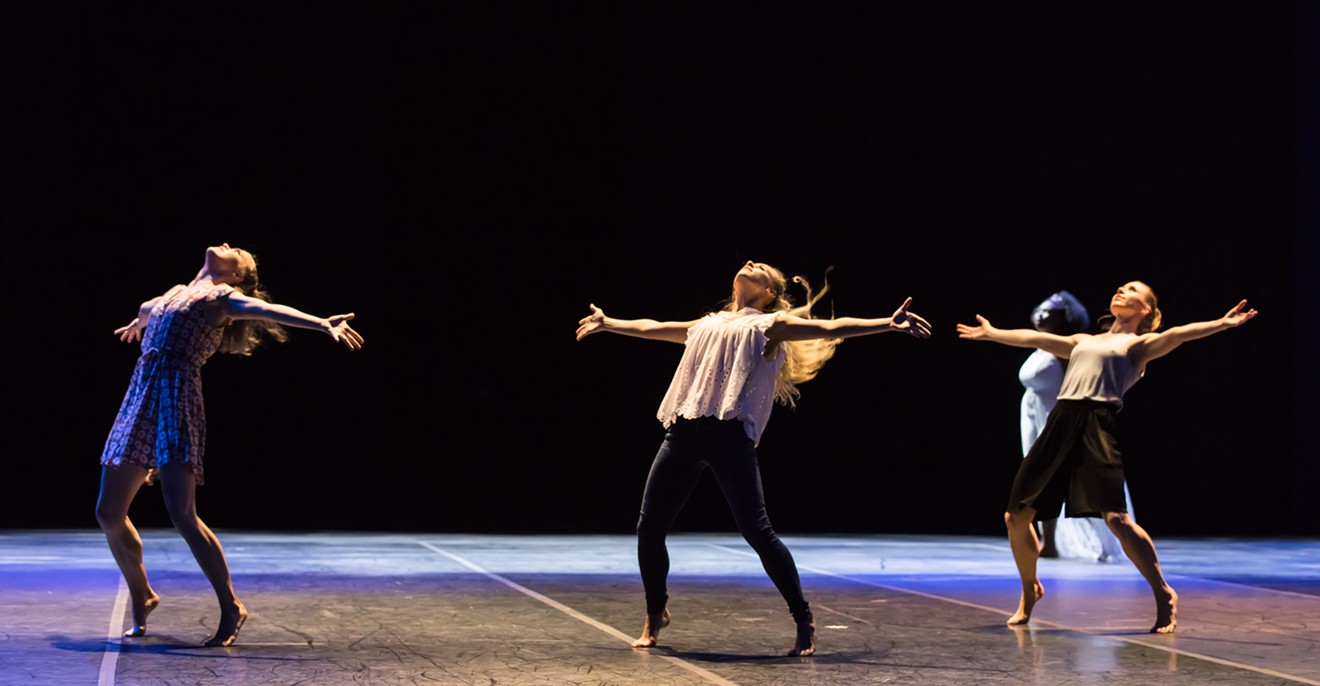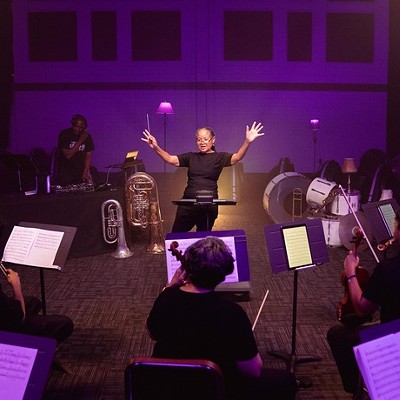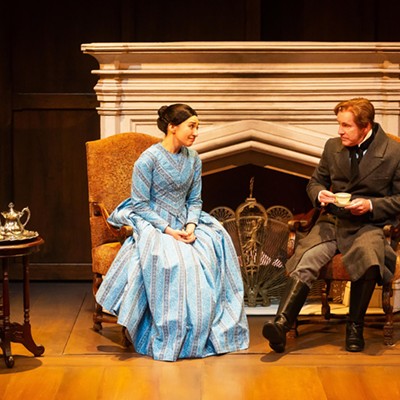Despite Play's inauspicious beginning as “Global Movements” on a press release back in January 2017, the monkey wrench known as Hurricane Harvey actually led the Houston Ballet’s final mixed repertory program of the season to a much more meaningful place: the George R. Brown Convention Center, which Artistic Director Stanton Welch and Co. used as a springboard for creativity leading to the creation of works much more personal and cathartic. Where Poetry in Motion was a “modern love letter to ballet” and Rock, Roll & Tutus was a celebration of its rock ‘n’ roll spirit, Play is both a love letter to Houston and a celebration of resilience, not to mention a show of unity, strength and ingenuity. Lemonade from the lemons Harvey left behind.
Stanton Welch’s deconstruction of life in the big city, Play, set to eight tracks from Moby’s 1999 album of the same name, opens the evening. In Play, Welch finds the rhythms and the poetry of mundane tasks – from pulling a shirt over your head and brushing your teeth to sneezing and taking a selfie. Dancers in suits and street clothes (in pointe shoes that look like sneakers) move as if puppeteered, with much of their motion centered in their upper body, composed gestures and jerky torsos, before the song changes, with subsequent sections more gentle, some more violent and some more whimsical until the free-for-all toward the end with all sorts of dance moves being broken out across the floor, from disco to voguing.
Moby's songs aren't quite as ubiquitous as they were around the turn of the century, when Moby was licensing the heck out of his music, and the distance makes Play even more effective.
The first of three world premieres from Welch, titled class, follows after a 25-minute intermission. To a selection from Johan Sebastian Bach’s Goldberg Variations, played effortlessly by pianist Katherine Burkwall-Ciscon, a “class” of 18 in tights, leotards, fitted tees and shorts skip the barre and go straight into center work. Welch’s choreography shows the simple beauty found inside the ballet studio, from the controlled strength of classical positions to agile pointe and partner work, with Burkwall-Ciscon’s serene, almost melancholy playing only enhancing the work’s delicate fragility. Though like Play in its attempt to represent a very specific world, it’s completely different in technique and mood, and side by side on the program, the juxtaposition allows you to appreciate them both all the more.

Houston Ballet Demi Soloist Rhodes Elliot (Left), Demi Soloist Brian Waldrep (Back) and Soloist Aaron Daniel Sharratt (Right) perform alongside local performance poet Outspoken Bean (Center) in Stanton Welch’s What the H Stands For.
Photo by Amitava Sarkar, Courtesy of Houston Ballet
In Revisit, Rebirth, Revolt, Jessica Collado, Tyler Donatelli and Bridget Kuhns embody the beautiful perspective offered by Mouton, sometimes two-stepping and sometimes as cattle or builders, as she takes us from the birth of Houston to today, extolling the city’s continued resilience before stating, “We aren’t going anywhere but here.”
Outspoken Bean provides an even more dynamic spoken-word soundtrack for What the H Stands For, taking the stage with eight dancers to remind us that hurricanes are “nothing more than visitors” and shout-out all the things the Houston is and has produced, with great energy and humor, before fiercely declaring what the “H” doesn’t stand for.
Welch’s choreography is serviceable if a bit uninspired, but is undeniably overshadowed by the talent of both Mouton and Outspoken Bean.
Closing the second act is What we keep, choreographed by three Houston Ballet dancers, Soloist Oliver Halkowich and Principals Melody Mennite and Connor Walsh, to an insistent electronic score from James Templeton. The dance itself is intense and modern, sharp and at times chaotic, but coupled with Templeton’s music, which incorporates voiceovers from 1950s educational films like Holiday from Rules? and Health: Your Posture, the piece becomes surreal and thematically muddled.
Closing the program is Welch’s Bolero Triptych, which brings the entire company on stage dancing to Maurice Ravel’s Bolero.

Artists of Houston Ballet perform in What we keep, choreographed by Houston Ballet Principal Melody Mennite, Soloist Oliver Halkowich and Principal Connor Walsh.
Photo by Amitava Sarkar, Courtesy of Houston Ballet
But it’s Bolero Triptych, which Welch tinkered with for this space, that exemplifies the beauty of the space the best. Dancers entered from aisles on all three sides of the hall and every inch of the makeshift stage was in use by an increasingly overwhelming number of dancers. The repetition of the piece is relentless and the crescendo breathtaking. The precision, impeccable timing and unity of the dancers combine perfectly. This is what a force of nature looks like.
It’s also worth noting that Lisa J. Pinkham’s lighting is as much a part of the show as any dance or music selection. Play boasts some dramatic notes. class is bathed in an otherworldly cool blue. And stark white light cuts across the stage in What we keep. Pinkham’s stamp is on this production and it is better for it.
The program appears cohesive in a surprising way – people going about their day in a big city, dancers doing what they do best, and then an interruption (Harvey), followed by examples of collaboration, community and a final display from the collective. On paper, the thread running through the program seems enough to account for any thematic or tonal shifts; in practice, however, it was not quite so seamless. Still, much of the program works and some parts, to quote a man sitting in Orchestra B who leapt from his seat to applaud after Bolero Triptych, are “fucking awesome.”
Performances of Play are scheduled for 7:30 p.m. June 9 and 2 p.m. June 10 at the George R. Brown Convention Center, 1001 Avenida de las Americas. For more information, call 713-227-2787 or visit houstonballet.org. $40 to $120.







